Aulisa Medical Devices Technologies GA1001 Bluetooth 4.0 BTLE Sensor User Manual
Taiwan Aulisa Medical Devices Techonologies Inc. Bluetooth 4.0 BTLE Sensor
User Manual

1
Aulisa Guardian Angel™ GA1001
Sensor Module
Instruction For Use
Taiwan Aulisa Medical Devices Technologies, Inc.
10F., No.3-2, Park St., Nangang Dist.,
Taipei City 115, Taiwan (R.O.C)
Tel +886-2-2655-7297
www.aulisa.com
©2016 Taiwan Aulisa Medical Devices Technologies, Inc
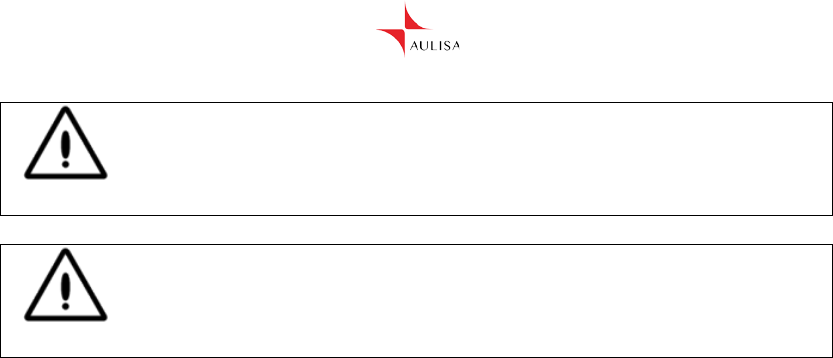
2
Warning!
Federal law (USA) restricts this device to sale by or on the order
of a licensed health care professional only.
Warning!
Read this entire manual carefully before using the Aulisa
GA1000 Digital Vital Sign Monitoring System
At the time of publication, this manual is believed to be accurate and up-to-date. In the
interest of continued product development, Taiwan Aulisa Medical Devices
Technologies, Inc. reserves the right to make changes and improvements to this
manual and the products described within at any time, without notice or obligation.
References to “Aulisa” in this manual shall imply Taiwan Aulisa Medical Devices
Technologies, Inc.
Aulisa is a registered trademark of Taiwan Aulisa Medical Devices Technologies, Inc.
Pre-Sense is a registered trademark of Taiwan Aulisa Medical Devices Technologies,
Inc.
Taiwan Aulisa Medical Devices Technologies, Inc.
10F., No.3-2, Park St., Nangang Dist.,
Taipei City 115, Taiwan (R.O.C)
Tel +886-2-2655-7297
www.aulisa.com
©2016 Taiwan Aulisa Medical Devices Technologies, Inc.

3
Table of contents
GUIDE TO SYMBOLS ............................................................................................................. 4
PRECAUTIONS FOR USE ...................................................................................................... 5
USING THE GA1001 ............................................................................................................. 12
INDICATIONS FOR USE ................................................................................................................ 13
CONTROLS, PORTS, INDICATORS, A N D DI S P L A Y S ..................................................................... 13
SHU TTI NG OF F TH E SYSTEM ....................................................................................................... 18
AL A R M RANGE AND INDICATORS ............................................................................................... 19
POWERING AND CHARGING ............................................................................................. 21
C A R E A N D M A I N T E N A N C E ................................................................................................ 23
SPECIFICATIONS ................................................................................................................. 24
PARTS AND ACCESSORIES............................................................................................... 26
SERVICE, SUPPORT, AND W A R R A N T Y ........................................................................... 27
TROUBLESHOOTING ........................................................................................................... 29
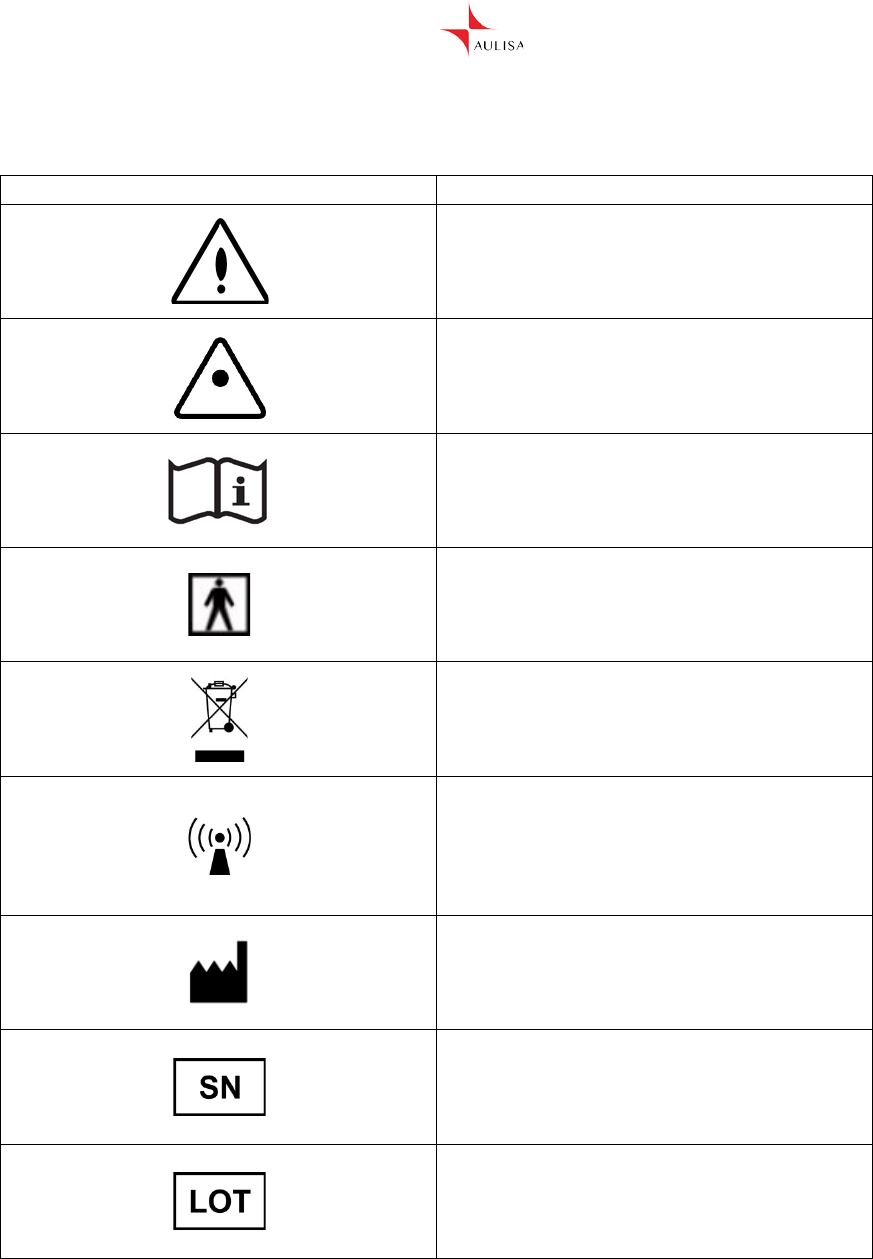
4
Guide to symbols
Table 1: Guide to symbols
Symbol
Description
Warning!
Caution!
Consult Instructions for Use.
Type BF-Applied Part (patient isolation
from electrical shock)
Indicates separate collection for
electrical and electronic equipment
(WEEE).
Non-ionizing electromagnetic
radiation. Equipment includes RF
transmitters. Interference may occur in
the vicinity of equipment marked with
this symbol.
Manufacturer
Serial number
Lot number
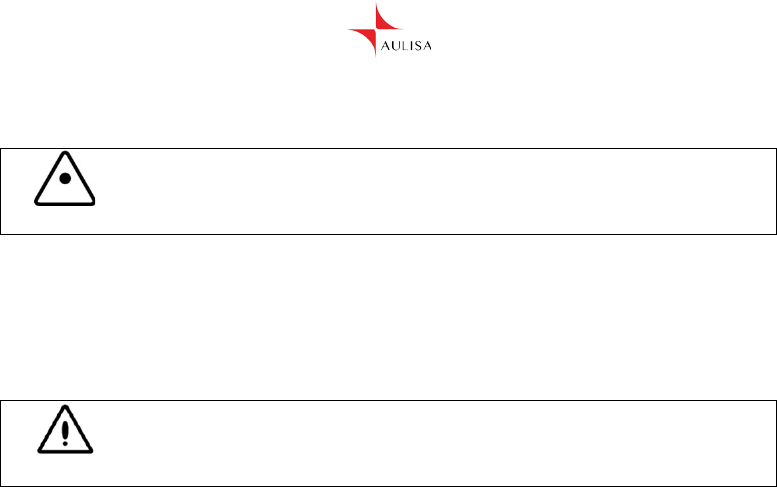
5
Precautions for Use
Caution!
Contraindications
1. Do not use any part of this system in an MRI environment.
2. Explosion Hazard: Do not use this system in an explosive atmosphere
or in the presence of flammable anesthetics or gases.
3. This device is not a replacement for a caregiver.
Warning!
Warnings
1. This system is intended only as an adjunct in patient assessment. It
must be used in conjunction with other methods of assessing clinical
signs and symptoms.
2. A functional tester cannot be used to assess the accuracy of a pulse
oximeter probe or a pulse oximeter monitor. Pulse oximeters do not
require calibration.
3. Oximeter readings may be affected by the use of an electrosurgical
unit.
4. Only use Aulisa manufactured sensors. These sensors are
manufactured to meet the accuracy specifications for Aulisa Digital
Vital Sign Monitoring Systems. Using other manufacturers’ sensors
can result in improper pulse oximeter performance and patient injury
may occur.
5. The operator must verify the compatibility of the sensor probe with the
Vital Sign Monitoring System before use, otherwise patient injury can
result
6. Misapplication of the sensor probe with excessive pressure for
prolonged periods can induce pressure injury
7. Do not use a damaged sensor.
8. Do not use in or around water or any other liquid.
9. Only use this vital sign monitoring system with GA1006 power
adapters provided by Aulisa.
10. This vital sign monitoring system is designed to determine functional
oxygen saturation, the percentage of arterial oxygen saturation of
functional hemoglobin. Significant levels of dysfunctional hemoglobin,
such as methemoglobin, might affect the accuracy of the measurement.

6
11. Use the vital sign monitoring system only when the components are
installed within the specified distances from the monitored patient –
approximately 10 meters (10.9 yards) spherical radius from pulse
oximetry Sensor Module to the wireless Display Unit. Moving outside
this range may cause missing, lost, and/or inaccurate data.
12. Loss of monitoring can result if any objects hinder the pulse
measurement. Ensure that no blood flow restrictors (e.g., blood
pressure cuff) hinder pulse measurements.
13. Do not place cord within reach of children, infants, and neonates.
14. This product is not a substitution for adult supervision.
15. Always refer to the Instructions For use for full warnings and
instructions.
16. Failure to follow instructions and warnings may result in serious injury
or death.
Caution!
Cautions
1. This equipment complies with International Standard EN 60601-1-
2:2001 for electromagnetic compatibility for medical electrical
equipment and/or systems. This standard is designed to provide
reasonable protection against harmful interference in a typical medical
installation. However, because of the proliferation of radio-frequency
transmitting equipment and other sources of electrical noise in
healthcare and other environments, it is possible that high levels of
interference due to close proximity or strength of a source might
disrupt the device’s performance.
2. If this vital sign monitoring system fails to respond as described,
discontinue use until the situation is corrected by qualified personnel.
3. Cardiogreen and other intravascular dyes may affect the accuracy of
SpO2 measurements.
4. The sensor might not work on cold extremities due to reduced
circulation. Warm or rub the extremity to increase circulation, or
reposition the sensor.
5. This system might misinterpret motion as good pulse quality. Minimize
motion of the monitored site.
6. Some nail polish colors or artificial nails can reduce light transmission
and affect SpO2 accuracy.
7. Inspect the sensor application site at least every 6 to 8 hours to ensure
correct sensor alignment and skin integrity. Patient sensitivity to
sensors may vary due to medical status or skin condition.

7
8. The frequency of sensor relocation should be every 6-8 hours to
ensure correct sensor alignment and skin integrity. Patient sensitivity to
sensors may vary due to medical status or skin condition.
9. Do not place liquids on top of this pulse oximetry system.
10. Do not immerse the pulse oximetry system or sensors in any liquids.
11. Do not use caustic or abrasive cleaning agents on the unit or sensors.
12. Do not gas sterilize or autoclave this pulse oximetry system.
13. Dress all cords accordingly to prevent tripping and tangling.
14. Batteries might leak or explode if used or disposed of improperly.
15. Follow local governing ordinances and recycling instructions regarding
disposal or recycling of the device and device components, including
batteries.
16. Do not fasten the Sensor Module too tightly around the patient’s wrist
or ankle. Inaccurate readings and patient discomfort could result.
17. Caution: Exposure to Radio Frequency Radiation. The Sensor Module
has been tested and meets allowed limits for exposure

8
Declaration of Conformity with FCC for Electromagnetic
Compatibility
Taiwan Aulisa Medical Devices Technologies, Inc. of 10F., No.3-2, Park
St., Nangang Dist., Taipei City 115, Taiwan (R.O.C) declares under its
sole responsibility that the Aulisa Model GA1001, to which this declaration
relates, comply with part 15 of the FCC Rules. Operation is subject to the
following two conditions: (1) this device may not cause harmful
interference, and (2) this device must accept any interference received,
including interference that may cause undesired operation.
Federal Communications Commission (FCC) Notice
This equipment has been tested and found to comply with the limits for a
Class B digital device, pursuant to part 15 of the FCC Rules. These limits
are designed to provide reasonable protection against harmful
interference in a residential installation. This equipment generates, uses
and can radiate radio frequency energy and, if not installed and used in
accordance with the instructions, may cause harmful interference to radio
communications. However, there is no guarantee that interference will not
occur in a particular installation. If this equipment does cause harmful
interference to radio or television reception, which can be determined by
turning the equipment off and on, the user is encouraged to try to correct
the interference by one or more of the following measures: (1) Reorient or
relocate the receiving antenna. (2) Increase the separation between the
equipment and receiver. (3) Connect the equipment into an outlet on a
circuit different from that to which the receiver is connected. (4) Consult
the dealer or an experienced radio/TV technician for help.
The Aulisa Model GA1001 is designed and manufactured not to exceed
the emission limits for exposure to radio frequency (RF) energy set by the
Federal Communications Commission of the U.S. Government. These
limits are part of comprehensive guidelines and establish permitted levels
of RF energy for the general population. The guidelines are based on the
safety standards previously set by both U.S. and international standards
bodies. This equipment has been shown to be capable of compliance for
localized specific absorption rate (SAR) for uncontrolled environment/
general population exposure limits specified in ANSI/IEEE Std. C95.1-
1992 and has been tested in accordance with the measurement
procedures specified in IEEE Std. 1528-200X (Draft 6.5, January 2002).
RF Exposure: For body worn operation, to maintain compliance with FCC
RF exposure guidelines, use only accessories that contain no metallic
components. RF exposure separation distance is 5 mm. Use of other
accessories may violate FCC RF exposure guidelines and should be
avoided.
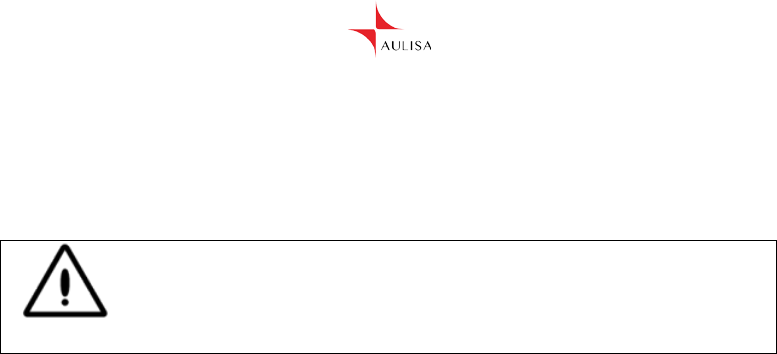
9
The FCC requires the user to be notified that any changes or
modifications to this device that are not expressly approved by Taiwan
Aulisa Medical Devices Technologies, Inc. may void the user’s authority to
operate the equipment.
Warning!
No modifications to this device are allowed that in any way
affect or alter its antenna or antenna configuration.
FCC Part 15.19 Warning Statement
This device complies with Part 15 of the FCC Rules. Operation is subject
to the following two conditions: (1) this device may not cause harmful
interference, and (2) this device must accept any interference received,
including interference that may cause undesired operation.
FCC Part 15.21 Warning Statement
The user manual for an intentional or unintentional radiator shall caution
the user that causes or modifications not expressly approved by the party
responsible for compliance could void the user’s authority to operate the
equipment.
GA1001 Sensor
NOTE: THE GRANTEE IS NOT RESPONSIBLE FOR ANY CHANGES
OR MODIFICATIONS NOT EXPRESSLY APPROVED BY THE PARTY
RESPONSIBLE FOR COMPLIANCE. SUCH MODIFICATIONS COULD
VOID THE USER’S AUTHORITY TO OPERATE THE EQUIPMENT.

10
Manufacturer Declaration
Scientific principal
The GA1001 measures SpO2 and Pulse rate based on transmittance
technology, measuring the absorbance of red and infrared light passed
through the tissue.
Safety and performance testing
The Aulisa Guardian Angel GA1001 Digital Vital Sign Monitoring Sensor
Module conforms to the following international standards:
Performance and safety
ISO 80601-2-61:2011 Particular requirements for basic safety and
essential performance of pulse oximeter equipment
Electromagnetic Emissions
IEC 60601-1-2:2014 General requirements for basic safety and
essential performance - Collateral Standard: Electromagnetic
disturbances - Requirements and tests
Accuracy testing
SpO2 Accuracy
SpO2 accuracy testing is performed by clinical trials on healthy adult
subjects with varying skin pigmentation in an independent research
laboratory through induced hypoxia studies. Analysis of bias1 was
performed vs. Hemoximeter data. The limits of agreement shown are
calculated per: Bland JM, Altman D. (2007) Agreement between methods
of measurement with multiple observations per individual. Journal of
Biopharmaceutical Statistics 17, 571 – 582.
Root mean square error (RMS error) is calculated as follows:
RMS Error =
()
1Bias is defined as the monitor under test reading minus the hemoximeter
reading.
Note: Because pulse oximeter equipment measurements are
statistically distributed, only about two-thirds of Aulisa GA1001
measurements can be expected to fall within ±Arms of the value
measured by a co-oximeter.

11
Pulse rate Accuracy
Pulse rate accuracy has been tested against an electronic pulse simulator
over the range of 30 to 300 bpm at 0.1 step of pulse amplitude from 0.5%
to 20%.
RMS Error =
()
Where PRAulisais the pulse rate measured by Aulisa GA1001 and
PRSimulator is the simulator setting of pulse rate.
Equipment Response Time
The GA1001 uses a moving average to determine the Pulse Rate and
SpO2. The following table shows the equipment response time of the
GA1001.
Equipment Delays
Delay (Seconds)
Data Averaging
≤ 4 seconds
Alarm Condition Delay
≤ 4 seconds
Alarm Signal Generation Delay
0 seconds
Data Update Period
1 second
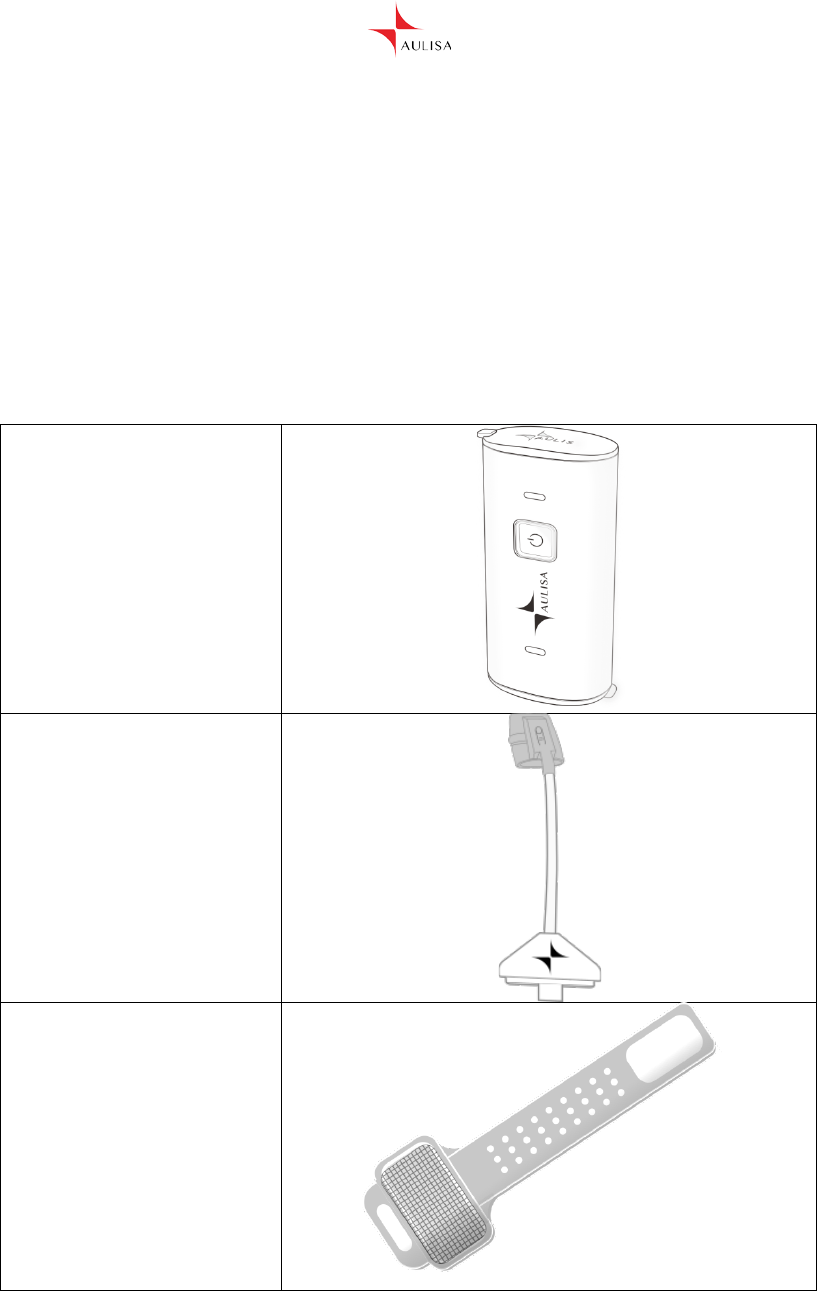
12
Using the GA1001
This chapter describes how to use the Aulisa GA1001 Guardian Angel
Digital Vital Sign Monitoring Sensor Module. The system includes the
following components and accessories:
GA1001 Sensor Module (x2)
GA1004 – SC100X Silicon finger sensor
GA1005 – WB100 Sensor Module wristband
GA1006 – M100 Sensor Module Charging Adaptor
Instructions For Use
GA1001
Sensor Module (x2)
GA1004 – SC100X
Silicon finger sensor
GA1005 – WB100
Sensor Module
wristband
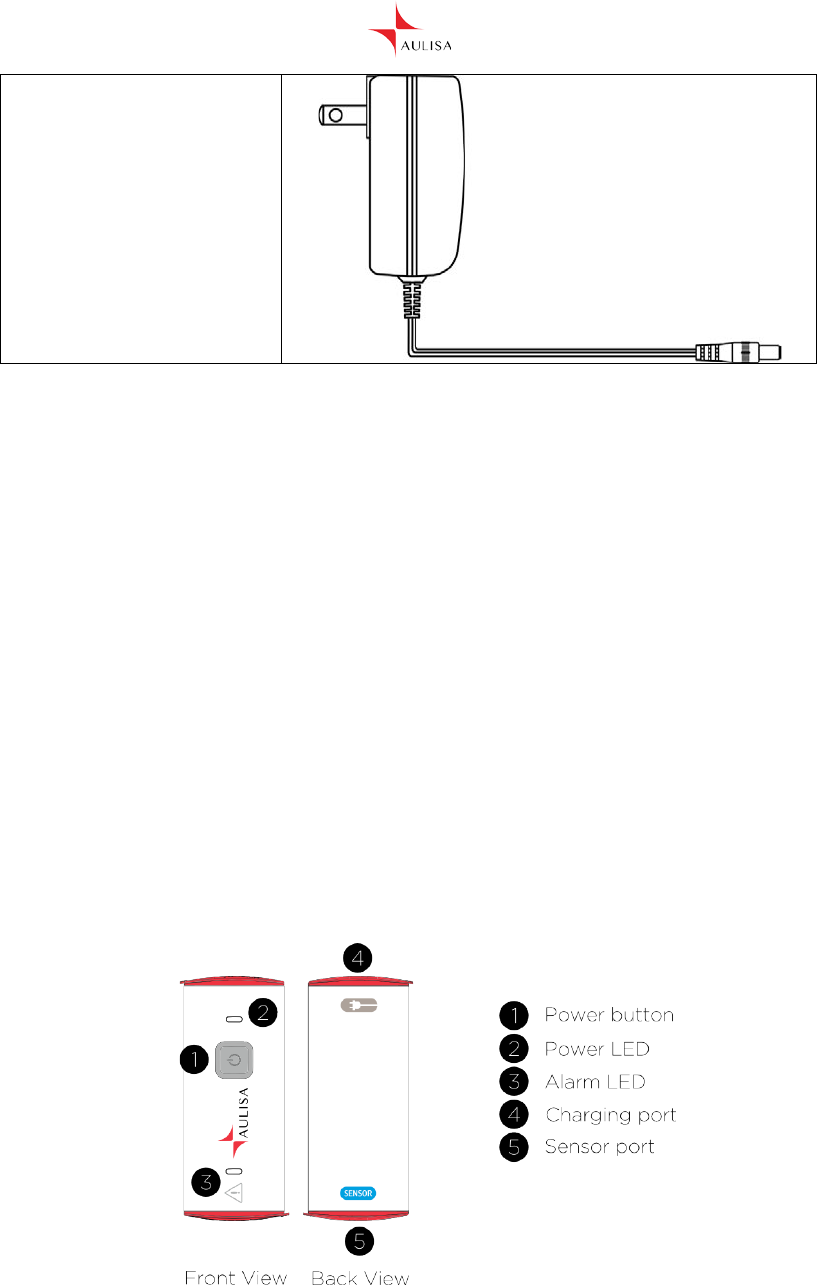
13
GA1006 – M100
Sensor Module
Charging Adaptor
Indications for Use
The AulisaTM Guardian AngelTM Model GA1001 Digital Vital Sign
Monitoring Sensor Module is indicated for use in measuring and displaying
functional oxygen saturation of arterial hemoglobin (SpO2) and pulse rate
of adult, pediatric, infant, and neonate patients. It is indicated for spot-
checking and / or continuous monitoring of patients during non-motion and
under well-perfused conditions..
Controls, Ports, Indicators, and Displays
This section describes the Aulisa Guardian Angel displays, indicators, and
controls for the Sensor Module.
Sensor Module
The Sensor Module includes a transmitter and a sensor, which is
worn by the patient for vital sign monitoring. It features sensors and
electronics for vital sign measuring and analyzing. The sensors can
be attached on the fingers, toes, or feet.
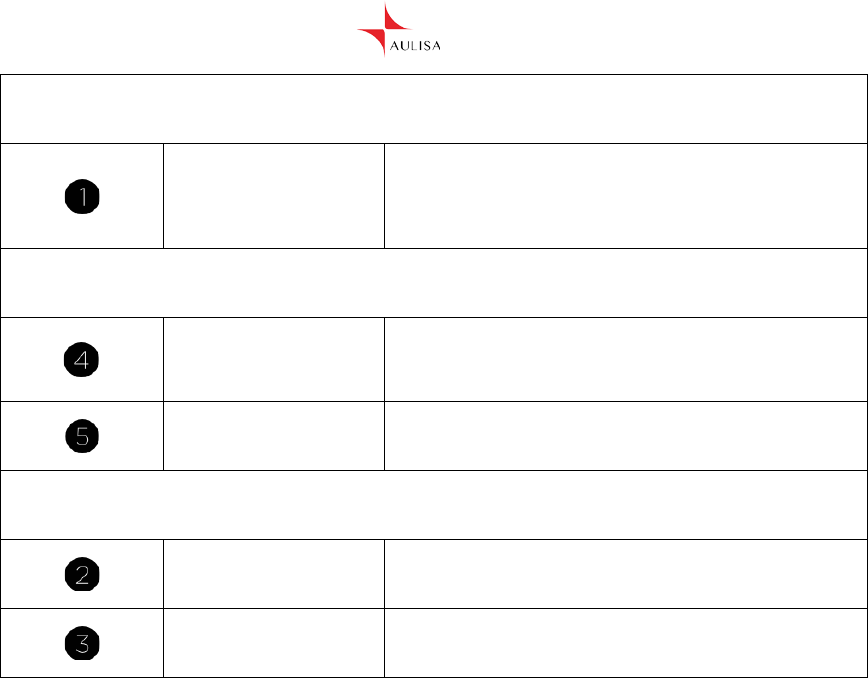
14
Hardware Control Buttons
Power button
Push this button to turn the Sensor Module
on or off.
Ports
Mini-USB
Charging Port
Charge the Sensor Module by connecting
the supplied GA1006-M100 Sensor Module
Charging Adaptor
Sensor Port
Connect the Sensor to the Sensor Module
through the sensor port.
Display Icons and Indicators
Power button and
Power Indicator
This icon identifies the power button and
power indicator.
Alarm Indicator
This icon identifies the alarm indicator.
Setting up the GA1000 system
Use the following procedure to set up the Aulisa GA1001 Digital Vital Sign
Monitoring Sensor Module:
Wristband
The wristband is used to secure the Sensor Module on a patient’s wrist.
Secure the wristband onto the patient’s wrist with the transparent pocket
facing outwards. Slip the Velcro end through the hole and loop around
to secure the wristband.
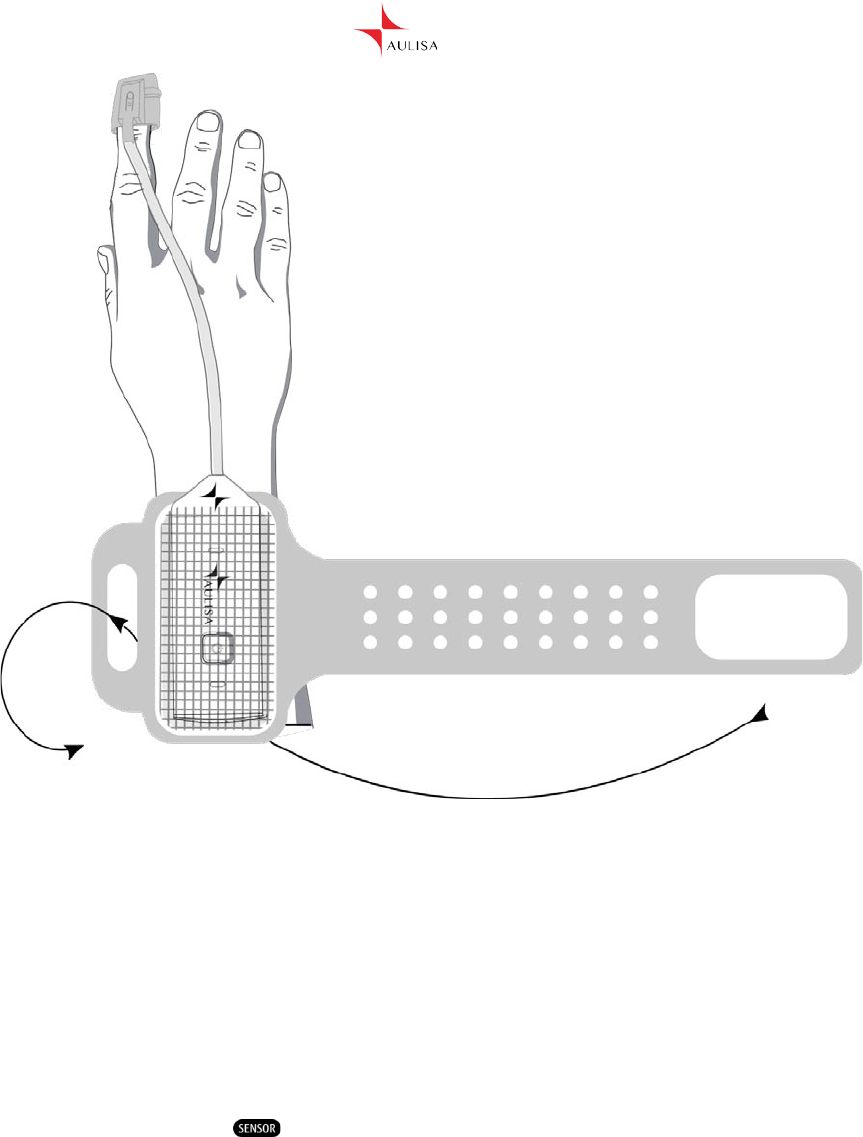
15
Adjust the wristband according to wrist size.
Sensor Module
Use the following procedure to power on the Sensor Module and pair
with the Display Unit(sold separately)..
Note: Please make sure to follow instructions in this particular order.
Otherwise, an alarm will go off indicating cable disconnection or finger
not detected..
1. Attach the Sensor connector to the Sensor Module port end
marked with .
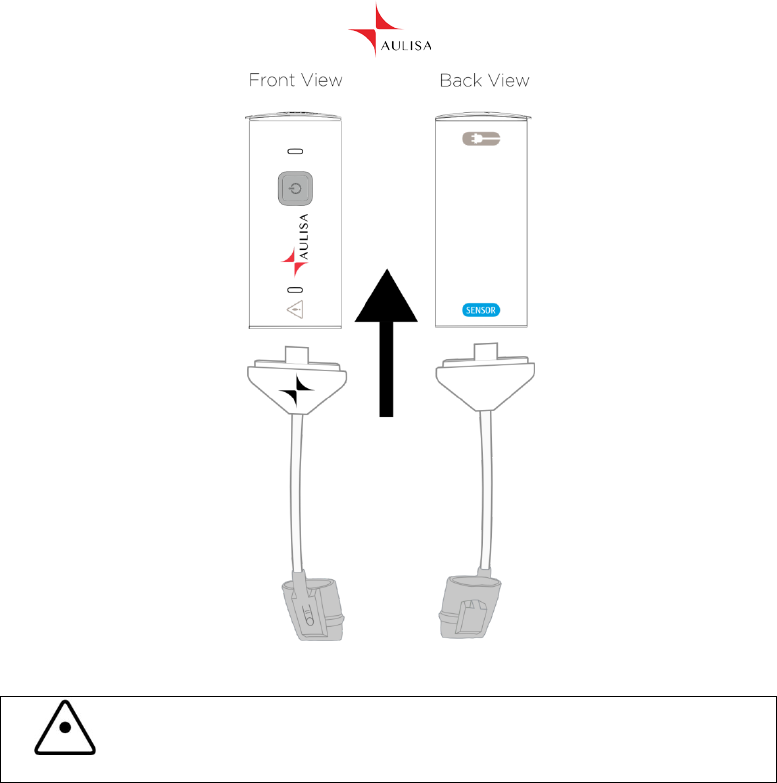
16
Caution!
Only use the sensors supplied or manufactured by Taiwan
Aulisa Medical Devices Technologies, Inc.
2. Insert the Sensor Module into the wristband mesh pocket.
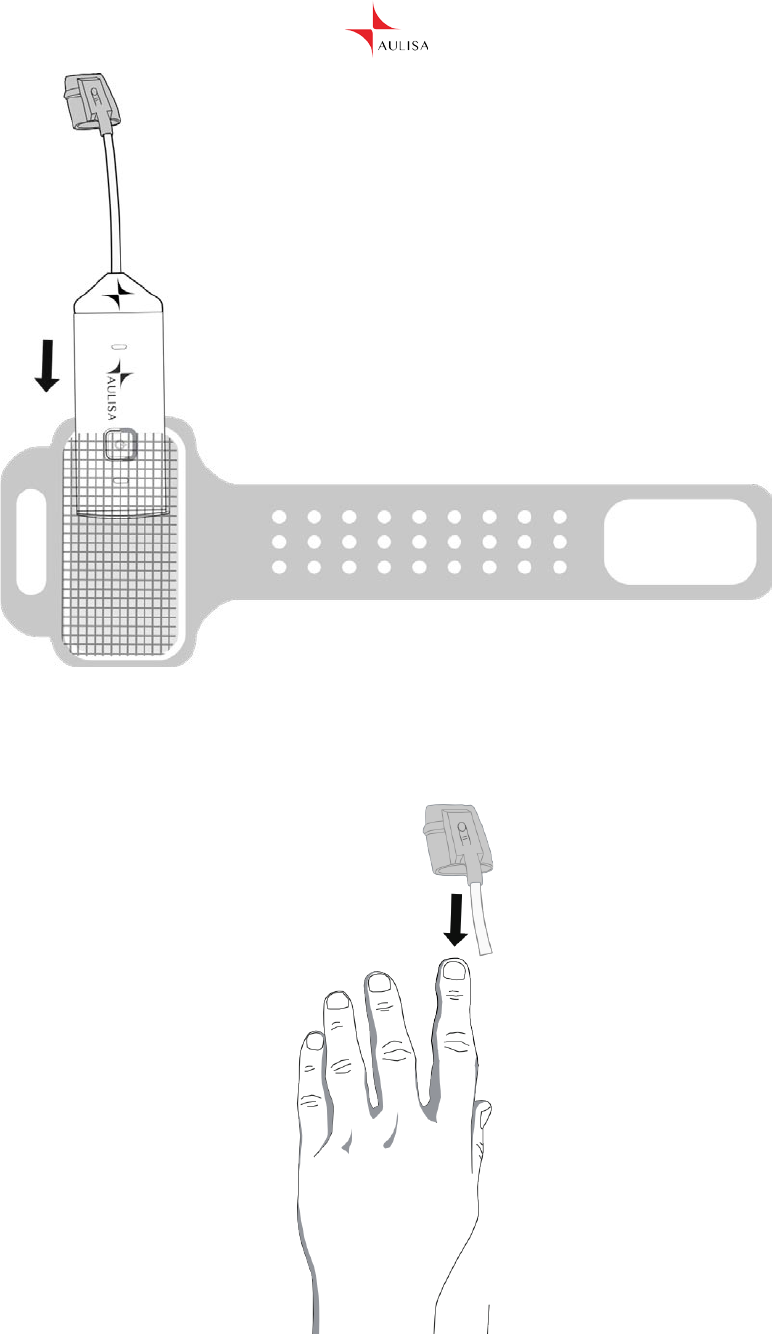
17
3. Put the GA1005-WB100 Wristband with the Sensor Module
inside onto the left or right hand.
4. Attach the Sensor probe to the thumb or finger.
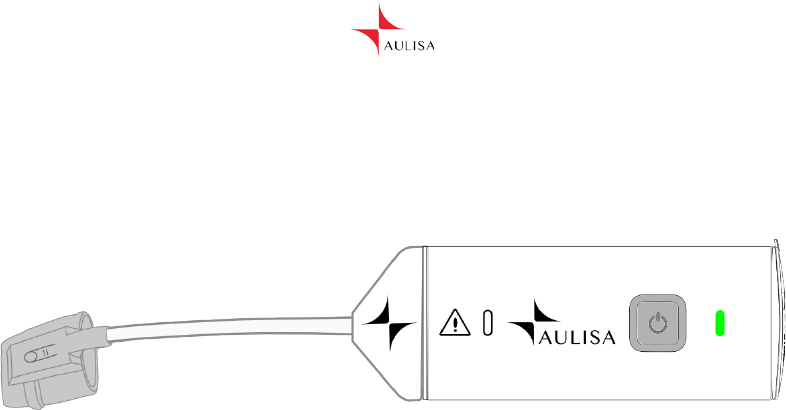
18
5. Turn on the Sensor Module by pushing the power button for at
least 1 second. The power indicator will light Green.
Note: The power indicator will blink green when pairing with the
Display Unit which is established, and data is being transmitted.
Shutting off the System
To turn off the Sensor Module, pressing the power button for at least 1
second.
Note: The Sensor Module will automatically power off when the adapter is
plugged in for charging.
Note: The sensor Module will automatically power off when it detects it is
not being used for 3 minutes.
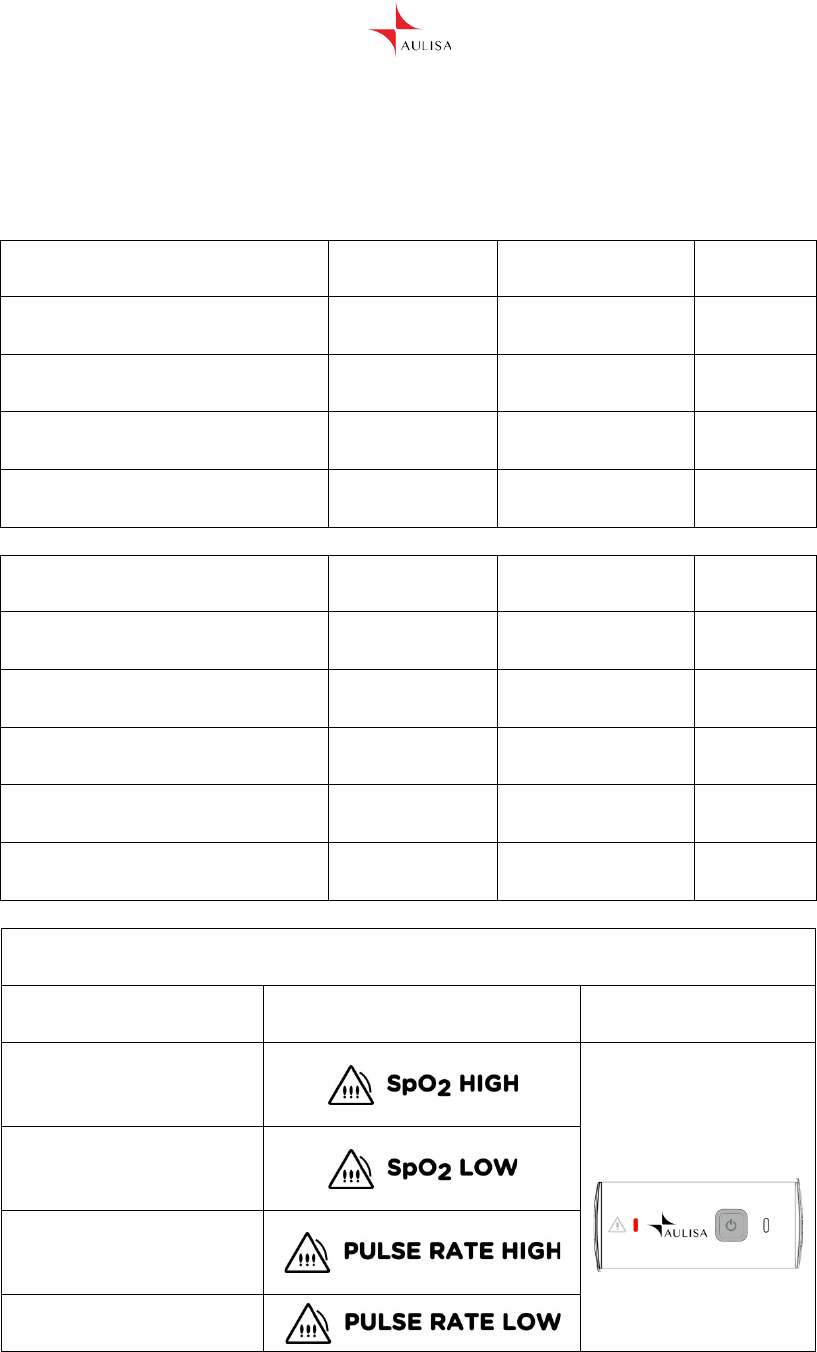
19
Alarm Range and Indicators
If patient SpO2 or pulse readings are equal to or above the upper Alarm
limit, or if they are equal to or below the lower Alarm limit, an Alarm will be
triggered.
High Priority A l a r m
Factory
Default
Adjustment
Range
Step
Value
SpO2 Upper Alarm Limit
100%, OFF
85 to 100
1%
SpO2 Lower Alarm Limit
85%, ON
50 to 95
1%
Pulse Rate Upper Alarm
Limit
200 bpm, ON
75 to 275
1 bpm
Pulse Rate Lower Alarm
Limit
50 bpm, ON
30 to 110
1 bpm
Low Priority Alarm
Factory
Default
Adjustment
Range
Step
Value
Data Update Period Exceed
Limit
30 seconds
N/A
N/A
Sensor Cable Probe Fault
ON
N/A
N/A
Sensor Probe Detached
from Patient
ON
N/A
N/A
Sensor Module Battery Low
2 hours
N/A
N/A
Sensor Module
Disconnected
On
N/A
N/A
Alarm Indicators
Alarm Condition
Display Unit
Sensor Module
SpO2 is too high
Alarm LED flashes
Red
SpO2 is too low
Pulse Rate is too high
Pulse Rate is too low
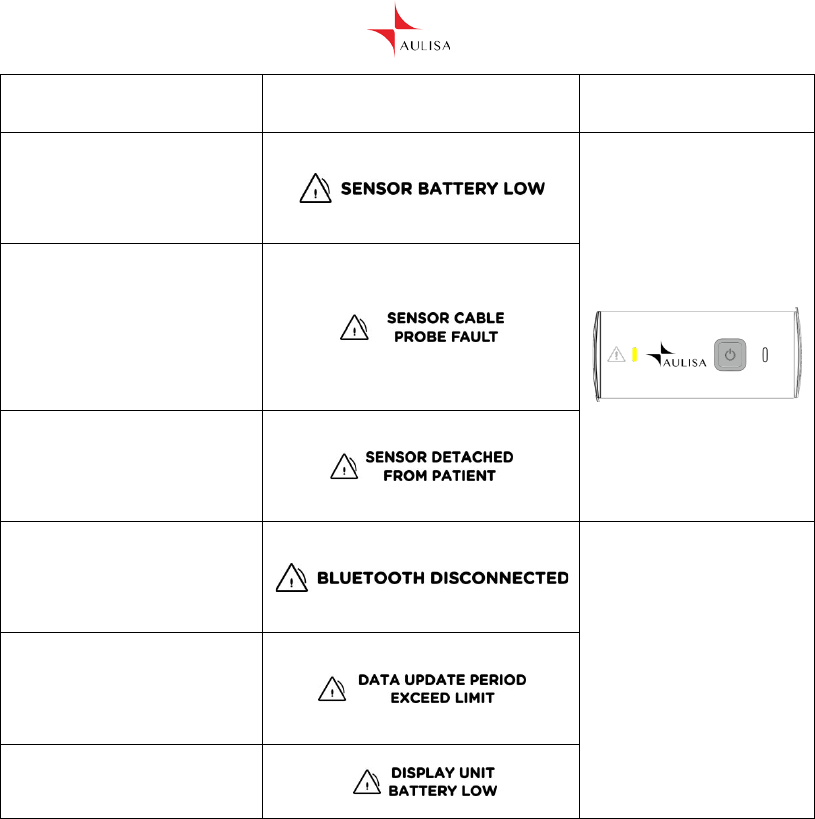
20
Sensor Module
Battery is low
Alarm LED lights
Yellow
Sensor cable
disconnected
Sensor Cable wire
shorted
Sensor cable wire
opened
Sensor probe
detached from patient
Sensor Module
Disconnected
NA
Data update period
has exceeded limit
Display Unit Battery
Low
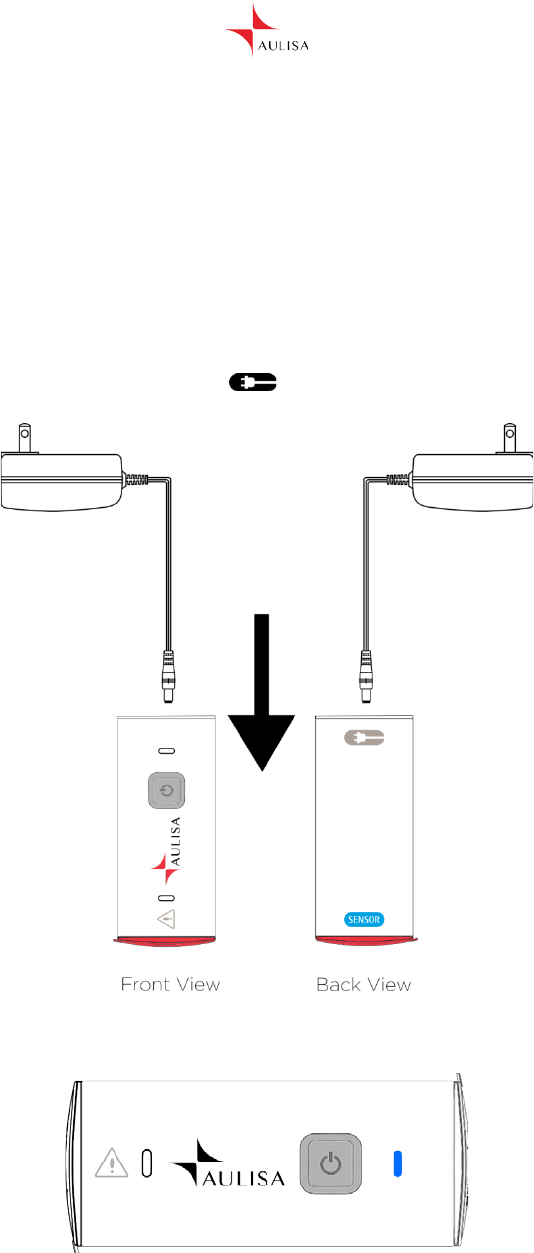
21
Powering and Charging
Charging the Sensor Module
1. Once on low battery, the Sensor Module will work for another 2
hours (approximately).
2. Charge the Sensor Module with the GA1006-M100 charging
adapter.
3. Attach the wall adaptor to a power outlet.
4. Plug the mini-USB end of the cable into the charging port on the
Sensor Module marked by .
5. The Power LED will light blue while charging and turn off when fully
charged.
6. Charging from empty power will take approximately 3 hours, and
the Power LED will turn off.

22
Caution!
Only use cables and adaptors supplied or manufactured
by Taiwan Aulisa Medical Devices Technologies, Inc.
Caution!
The Sensor Module cannot be used to measure vital signs
while it is being charged.
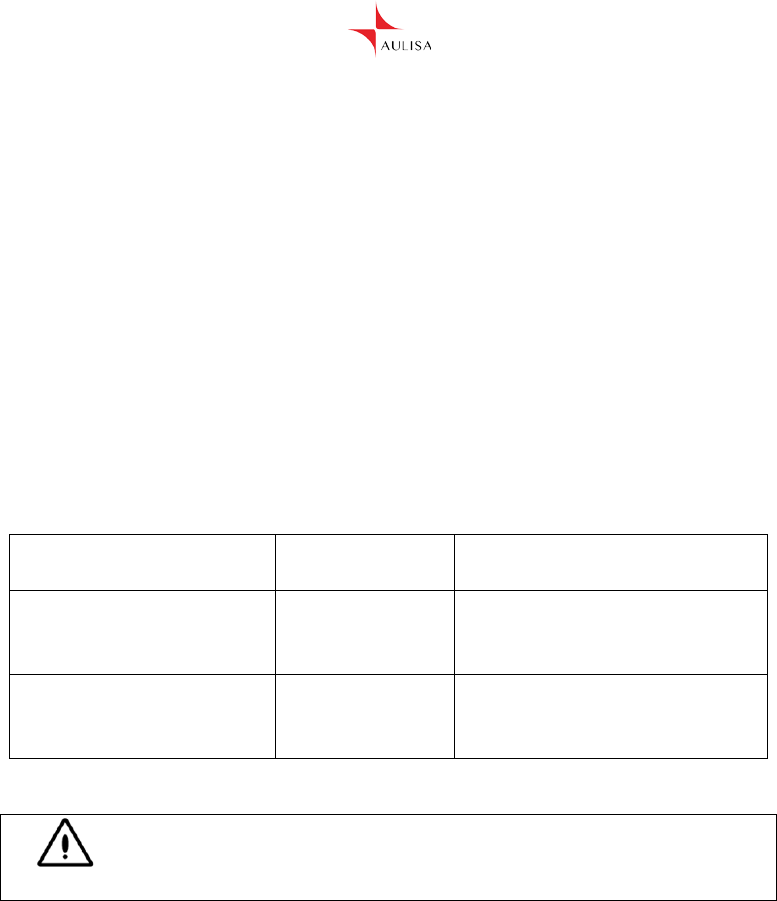
23
Care and Maintenance
The advanced digital circuitry within the Sensor Module of this system
requires no calibration or periodic maintenance.
Field repair of system circuitry is not possible. Do not attempt to open the
case or repair the electronics. Opening the Sensor Module will damage
the device and void the warranty. If the system is not functioning properly,
please refer to the “Troubleshooting” section.
Cleaning the Sensor Module Sensors
Aulisa produces a wide variety of sensors for different applications and
needs. Some sensors can be cleaned while some are disposable. To
determine if your sensor can be cleaned, please identify the part number
and follow the instructions below.
Sensor Model Number
Sensor
Material
Cleaning instructions
GA1004- FM100X
Foam
These sensors are
disposable and therefore
cannot be cleaned.
GA1004- SC100X
Silicon
Clean with a soft cloth
dampened with rubbing
alcohol.
Warning!
Do not immerse the device in liquid, and do not use
caustic or abrasive cleaning agents on the device.

24
Specifications
Aulisa GA1001 Digital Vital Sign Monitoring Sensor Module
Blood Oxygen Saturation
Display Range (SpO2)
0% to 100%
Pulse Rate D i s p l a y Range
30 to 290 bpm
Accuracy
Blood Oxygen Saturation
(%SpO2) (± 1 S.D.)
SC100M
Silicon sensor
(Pediatric)
70-100% ± 3
digits
ENSC100L
Silicon sensor (Adult)
70-100% ± 3
digits
Pulse Rate
SC100M
Silicon sensor
(Pediatric)
± 3%
ENSC100L
Silicon sensor (Adult)
± 3%
Measurement Wavelengths and Output Power
Red
660 nanometers @ 1.8 mw nominal
Infrared
905 nanometers @ 2 mw nominal
Temperature
Operating
+ 5°C to + 40°C
Storage/Transportation
– 25°C without relative humidity
control
+ 70°C at a relative humidity up to 93
%, non-condensing
Operating Altitude
altitude ≤ 2 000 m.
Atmospheric Pressure
700 hPa to 1060 hPa
Humidity
Operating
15% to 93%, non-condensing
Storage/Transportation
10% to 95% relative humidity, non-
condensing
Sensor Module (Sensors integrated)
Internal Power
Battery
3.7 V battery
Operating Life
10 hours of continuous operation
Dimensions
Without sensors
0.7” H x 1.3” W x 2.7” D
16 mm H x 32 mm W x 68 mm D
Weight
1 ounce
28 grams
Ingress Protection
IP22
Classifications per IEC 60601- 1
Type of Protection
Class I (when on AC power with )
Internally powered (on battery power)

25
Degree of Protection
Type BF-Applied Part
Mode of Operation
Continuous
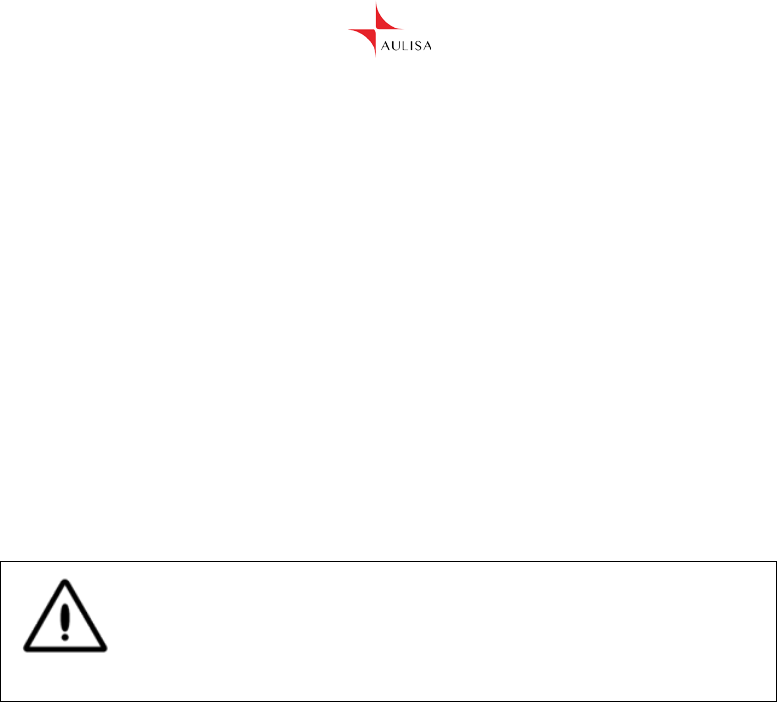
26
Parts and Accessories
Parts and Accessories
Part Number
Sensor Module
GA1001
Display Unit
GA1003
Sensors
Silicon Finger Sensor (Pediatric)
GA1004 – SC100M
Silicon Finger Sensor (Adult)
GA1004 – ENSC100L
Sensor Module Holder
Sensor Module Wristband
GA1005 – WB100
AC Adaptor
Sensor Module charging adaptor
GA1006 – M100
For more information about Aulisa parts and accessories, contact your
distributor, or contact Aulisa at 1 (650) 813-1273 (USA).
Warning!
Using sensors or accessories not by Taiwan Aulisa
Medical Devices Technologies, Inc. may result in
inaccurate measurements.
Always use parts and accessories by Taiwan Aulisa
Medical Devices Technologies, Inc.

27
Service, Support, and Warranty
A return authorization number is required before returning any product to
Aulisa.
To obtain this return authorization number, contact Aulisa Customer
Support:
United States of America
Aulisa Medical Technologies, Inc.
999 Commercial St, Suite 208
Palo Alto, CA 94303 USA
Tel (650) 813-1273
Taiwan
Taiwan Aulisa Medical Devices Technologies, Inc.
10F., No.3-2, YuanQu St., Nangang Dist.,
Taipei City 115, Taiwan (R.O.C)
Tel +886-2-2655-7297
www.aulisa.com
©2016 Taiwan Aulisa Medical Devices Technologies, Inc.
Warranty
Taiwan Aulisa Medical Devices Technologies, Inc., warrants to the
purchaser, for a period of one year from the date of purchase, the Aulisa
GA1001 Digital Vital Sign Monitoring Sensor Module. Aulisa warrants the
Sensor Module for a period of one year from the date of purchase. Aulisa
shall repair or replace any Sensor Module and integrated sensor(s) and
Display Unit found to be defective in accordance with this warranty, free of
charge, for which Aulisa has been notified by the purchaser by serial
number that there is a defect, provided said notification occurs within the
applicable warranty period. This warranty shall be the sole and exclusive
remedy by the purchaser hereunder for any Aulisa GUARDIAN ANGEL
GA1001 Digital Vital Sign Monitoring Sensor Module delivered to the
purchaser which is found to be defective in any manner, whether such
remedies be in contract, tort, or by law.
This warranty excludes cost of delivery to and from Aulisa. All repaired
units shall be received by the purchaser at Aulisa place of business.
Aulisa reserves the right to charge a fee for a warranty repair request on
any Aulisa GUARDIAN ANGEL GA1001 Digital Vital Sign Monitoring
Sensor Module that is found to be within specifications.
This system is a precision electronic instrument and must be repaired by
knowledgeable and specially trained Aulisa personnel only. Accordingly,
any sign or evidence of opening the devices, field service by non- Aulisa

28
personnel, tampering, or any kind of misuse or abuse of the system, shall
void the warranty in its entirety. All non-warranty work shall be done
according to Aulisa standard rates and charges in effect at the time of
delivery to Aulisa.
DISCLAIMER/EXCLUSIVITY OF WARRANTY:
The express warranties set forth in this manual are exclusive and no other
warranties of any kind, whether statutory, written, oral, or implied,
including warranties of fitness for a particular purpose or merchantability,
shall apply.

29
Troubleshooting
Problem
Possible Solution
The Sensor Module
will not turn on.
Press the Power On/Off button for more than
one(1) second.
Fully charge the Sensor Module until the
charging LED (Blue) turns off.
If these solutions do not correct the problem, please contact your
distributor, or contact Aulisa Customer Support at 1 (650) 813-1273 (USA).
Warning!
This system is a precision electronic instrument and must
be repaired by knowledgeable and specially trained Aulisa
personnel only. Do not attempt to open the case or repair
the electronics.

30
Taiwan Aulisa Medical Devices Technologies, Inc.
10F., No.3-2, Park St., Nangang Dist.,
Taipei City 115, Taiwan (R.O.C)
Tel +886-2-2655-7297
www.aulisa.com
©2016 Taiwan Aulisa Medical Devices Technologies, Inc.